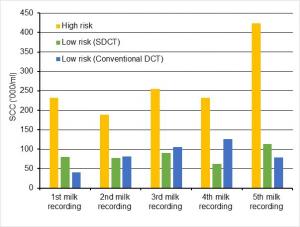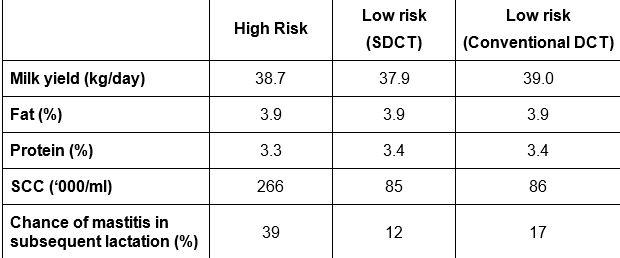Antimicrobial resistance (AMR) poses a serious threat to human health, and has the potential to contribute to 10 million deaths per year by 2050 if changes are not implemented (Review on antimicrobial resistance, 2016). As a result, there is increasing pressure to reduce antibiotic use within the livestock sector.

For that reason, the Agri-Food and Biosciences Institute (AFBI), in partnership with AgriSearch, Animal Health and Welfare Northern Ireland (AHWNI), Livestock and Meat Commission (LMC) and Farm Vet Systems, is leading a major research project entitled ‘STrategic AntiMicrobial use in Dairy, Beef and Lamb Production’ (STAMP). This project is co-funded through DAERA’s Research Challenge Fund.
Selective dry cow therapy (SDCT)
Conventional dry cow therapy (DCT) involves treating all four quarters of all cows’ with antibiotic dry-cow tubes at drying-off. This approach has long been standard practice on the majority of dairy farms, both to treat existing mammary infections and as a preventative measure against new infections during the dry-period. However, with improvements in both milking hygiene and cow genetics, average herd somatic cell count (SCC) has decreased in recent years, from 248,000 cells/ml in 2011 to 197,000 cells per ml in 2019. As a result of these improvements in udder health, there may now be an opportunity for many dairy farms to reduce antibiotic use at drying-off.
Selective dry cow therapy (SDCT), as the name suggests, involves being more selective about which cows are treated with antibiotics at drying-off, and limiting antibiotic use to those cows that are considered ‘high risk’. ‘High risk’ cows are normally identified based on their milk SCC levels and their mastitis history during the months prior to drying-off. In contrast, cows considered ‘low risk’ receive no antibiotic treatment and are dried-off using teat-sealant only.
While a number of local farmers have already adopted SDCT, relatively few studies have compared the two approaches to drying-off cows. In addition, there is currently no clear approach to identify ‘high risk’ cows, while there are concerns that adopting SDCT may increase mastitis incidence in the following lactation, and as a result, negate any reduction in antibiotic use.
AFBI research
The effects of adopting selective dry cow therapy at drying-off was examined in a two year study involving almost 400 cows, within the dairy herd at AFBI Hillsborough.
In this study cows were considered to be ‘high risk’ if they had a SCC greater than 200,000 cells/ml during any of the last three monthly milk recordings prior to drying off, or had one or more cases of mastitis during the 3 month period prior to dry-off. These ‘high risk’ cows received conventional DCT (all quarters treated with intramammary antibiotic tube and teat sealant at dry-off). Cows with a SCC of less than 200,000 cell/ml during the three milk recordings prior to drying-off, and with no cases of mastitis during the 3 months prior to dry-off, were identified as ‘low risk’ and were considered not to need antibiotics at drying-off. However, in order to evaluate the practice of SDCT, these ‘low risk’ cows were allocated to one of two treatments; either conventional DCT (all quarters treated with intramammary antibiotic tube and teat sealant at drying-off) or Selective DCT (treated with teat sealant only). Cows in the ‘high risk’ group had a mean lactation number of 4.1, compared to 3.1 for the ‘low risk’ group, highlighting that SCC and mastitis incidence generally increases with increasing lactation number. Cows were monitored for the first five months post-calving.

During the first five months post-calving, neither milk yield nor milk composition were affected by drying-off approach adopted (Table 1: Average daily milk yield, milk composition, SCC and mastitis incidence over the first five milk recordings for ‘high risk’ cows which received antibiotic plus teat sealant, and for ‘low risk’ cows subject to either SDCT (teat sealant only) or conventional DCT (antibiotic plus teat sealant).
As expected, ‘high risk’ cows had a higher SCC than ‘low risk’ cows during the first five milk recordings post-calving. However, drying-off treatment had no effect on the SCC of ‘low risk’ cows, those dried-off using conventional DCT having an average SCC of 86,000 cells/ml, while those dried-off using SDCT had an average SCC of 85,000 cells/ml (Figure 1). Furthermore, on average ‘high risk’ cows had a 39% chance of developing mastitis during the subsequent lactation, while ‘low risk’ cows dried-off using either SDCT or conventional DCT had a similar chance developing mastitis post-calving (12% and 17% chance of mastitis in the subsequent lactation; Table 1).
These findings demonstrate that when cows categorised as ‘low risk’ were dried-off without the use of antibiotics, their SCC levels and mastitis incidence during the subsequent lactation were similar to those of ‘low risk’ cows dried off using conventional antibiotic treatment. Thus there is real opportunity for local dairy farmers to dramatically reduce intramammary antimicrobial use, through a selective approach to dry cow therapy.
Indeed, EU legislation banning the preventative use of antibiotics will mean that compulsory implementation of SDCT in EU countries will happen by early 2022 and it is likely such legislation will be introduced in the UK. Given this, it is important for farmers to start to plan ahead and consider some key points.
Firstly, making decisions on whether to adopt SDCT on your farm, and which individual cows to dry-off without the use of antibiotics, requires good information on your herd, and on individual cows. For example, being able to identify the SCC of individual cows, and having excellent mastitis records for each cow, are essential.
Secondly, while excellent hygiene at drying-off is always important, it is especially so if not using an antibiotic, to minimise the risk of introducing bacteria into the udder.
If you are considering adopting SDCT on your farm, speak with your vet who can provide additional information and help to develop an appropriate plan at drying-off.
Notes to editors:
AFBI is an arms-length body of DAERA delivering research and development, diagnostic and analytical testing, emergency response capability and expert scientific advice for DAERA and other government departments, public bodies and commercial companies in Northern Ireland, and further afield.
AFBI’s Vision is “Advancing the Local and Global Agri-Food Sectors Through Scientific Excellence”.
AFBI’s core areas:
- Leading improvements in the agri-food industry;
- Protecting animal, plant and human health;
- Enhancing the natural and marine environment.
Latest news
- AFBI issues Nematodirus warning – Spring 2025 11 April 2025
- Managing Nature Based Risks to the UK Economy and Opportunities for Green Finance 08 April 2025
- AFBI Hillsborough host AERA committee 27 March 2025
- The Omics Days Conference 27 March 2025
